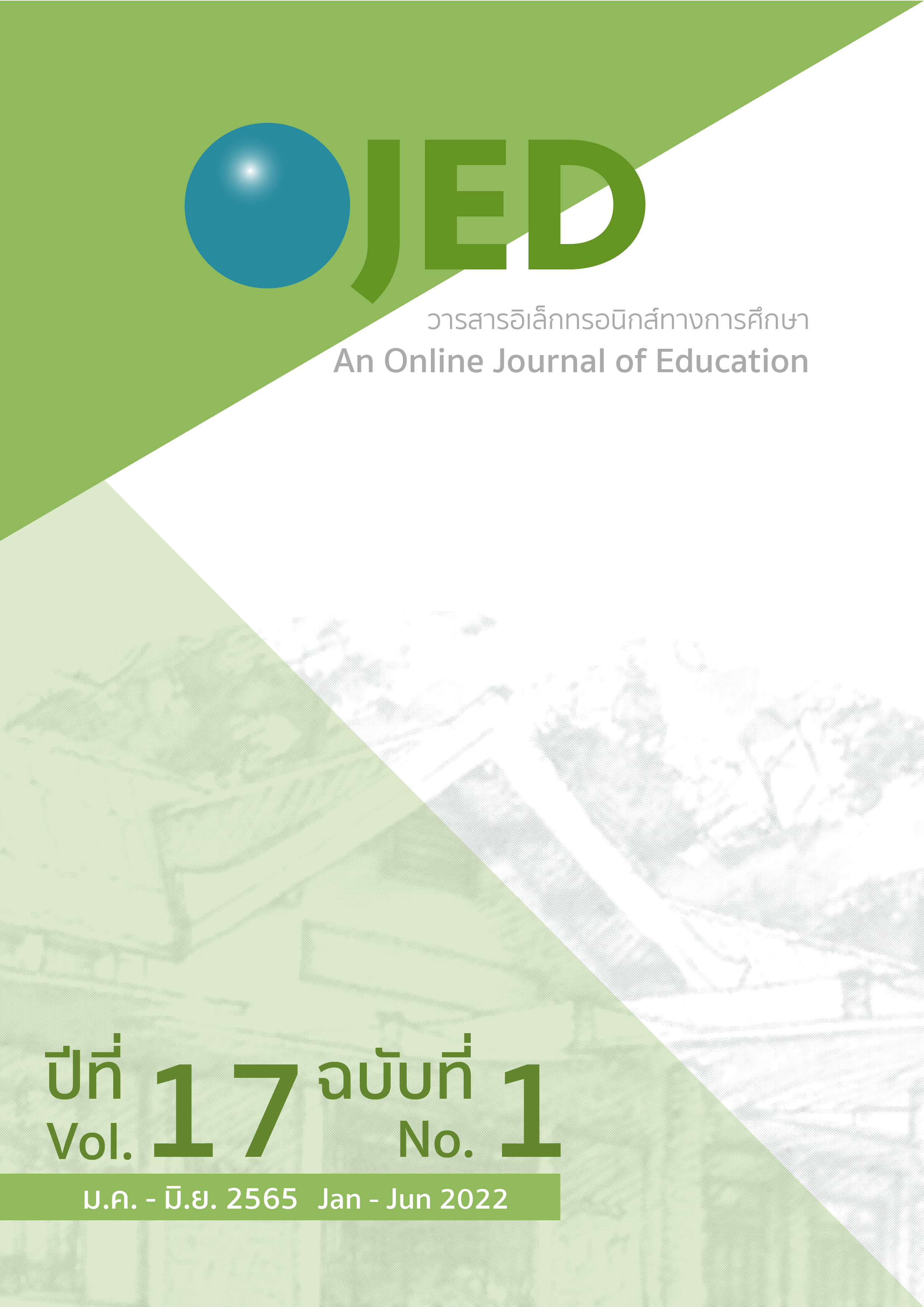Comparison of Psychometric Properties Integrating Indicators of Reading Analytical Thinking and Writing Abilities and Indicators of Content Science of Nine Grade Using the Different Item Review Methods
DOI:
https://doi.org/10.14456/ojed.2022.33Keywords:
item review methods, abilities of reading analytical thinking and writing, psychometric properties item review methodsAbstract
The purposes of this research were to compare the psychometric properties integrating indicators of reading analytical thinking and writing abilities and indicators of content science of nine grade using the different item review methods. The participants in this research comprised of 750 students in grade 9 and the data was collected through integrating test indicators of reading analytical thinking and writing abilities and indicators of content science of nine grade. Tests were divided into test A and B, a test is self item review and B test is item review with expert group. Researcher analyzed psychometric properties using classical test theory and item response model. The research findings were as follows:
1) The test is used in three dimensions school have the content validity of the two test
2) Reliability of the test in small size school and big size school, the reliability was low in the two test. But the test in medium size school, the reliability was high in the two test
3) Analysis of classical test theory and item response model, the difficulty and discrimination of the two test are not different.
References
จุฑา ธรรมชาติ. (2549). การศึกษาและวิเคราะห์สภาพการใช้แบบสอบอัตนัย ในการวัดและประเมินผลการเรียนรู้ของผู้เรียนระดับการศึกษาขั้นพื้นฐาน [วิทยานิพนธ์ปริญญามหาบัณฑิต]. จุฬาลงกรณ์มหาวิทยาลัย.
โชติกา ภาษีผล. (2555). การวัดและประเมินผลการศึกษา. โรงพิมพ์แห่งจุฬาลงกรณ์มหาวิทยาลัย
ณัฐภรณ์ หลาวทอง. (2548). เอกสารประกอบการสอน การวัดและประเมินผลการศึกษา [เอกสารที่ไม่ได้ตีพิมพ์]. คณะครุศาสตร์, จุฬาลงกรณ์มหาวิทยาลัย.
พรพิไล หาญทวีวงศา. (2529). ปัญหาการสร้างข้อสอบวัดความสามารถทางพุทธิพิสัยวิชาวิทยาศาสตร์ ระดับชั้นมัธยมศึกษาตอนปลายตามการรับรู้ของครูวิทยาศาสตร์ [วิทยานิพนธ์ปริญญามหาบัณฑิต]. จุฬาลงกรณ์มหาวิทยาลัย.
พิณสุดา สิริธรังศรี. (2556). รูปแบบการบริหารจัดการสถานศึกษาขั้นพื้นฐาน. www.dpu.ac.th/ces/download.php?filename=1392026465.pdf
พินดา วราสุนันท์. (2554). การพัฒนาศักยภาพทางการประเมินในด้านการสร้างข้อสอบของครูประถมศึกษาโดยใช้เครือข่ายมิตรวิพากษ์ [วิทยานิพนธ์ปริญญาดุษฎีบัณฑิต]. จุฬาลงกรณ์มหาวิทยาลัย.
เยาวดี วิบูลย์ศรี. (2534). การวัดผลเบื้องต้น. โรงพิมพ์แห่งจุฬาลงกรณ์มหาวิทยาลัย.
วชิราวุธวิทยาลัย. (2557). พัฒนาการสร้างข้อสอบและแนวทางการจัดทำข้อสอบ. http://www.vajiravudh.ac.th/index1.php
วิเชียร เกตุสิงห์. (2530). หลักการสร้างและวิเคราะห์เครื่องมือที่ใช้ในการวิจัย. ไทยวัฒนาพานิช.
ศิริชัย กาญจนวาสี. (2552). ทฤษฎีการทดสอบแบบดั้งเดิม (พิมพ์ครั้งที่ 6). โรงพิมพ์แห่งจุฬาลงกรณ์มหาวิทยาลัย.
สุกัญญา คล้ายทอง. (2546). การประเมินความตรงตามเนื้อหาและความเท่าเทียมกันของเนื้อหาในแบบสอบคู่ขนานโดยใช้โมเดลสมการโครงสร้าง [วิทยานิพนธ์ปริญญามหาบัณฑิต]. จุฬาลงกรณ์มหาวิทยาลัย.
สุจิตรา เทียนสวัสดิ์. (2550). ดัชนีความตรงเชิงเนื้อหา: ข้อพิพากษ์และข้อเสนอแนะวิธีการคำนวณ. พยาบาลสาร, 34(4), 1-9.
สถาบันส่งเสริมการสอนวิทยาศาสตร์และเทคโนโลยี. (2557). กระบวนการพัฒนาข้อสอบเลือกตอบ. http://sa.ipst.ac.th/?p=715
อนันดา สัณฐิติวณิชย์. (2556). การพัฒนาลักษณะเฉพาะของแบบสอบที่บูรณาการระหว่างตัวชี้วัดความสามารถด้านการอ่าน การคิดวิเคราะห์ และการเขียน กับตัวชี้วัดการประเมินสาระการเรียนรู้: การประยุกต์ใช้ทฤษฎีการตอบสนองข้อสอบแบบพหุมิติ. [วิทยานิพนธ์ปริญญาดุษฎีบัณฑิต]. จุฬาลงกรณ์มหาวิทยาลัย.
อนันต์ ศรีโสภา. (2524). การวัดและประเมินผลการศึกษา. ไทยวัฒนาพานิช.
เอมอร จังศิริพรปกรณ์. (2545). การเปรียบเทียบคุณภาพของแบบสอบเลือกตอบเมื่อตรวจด้วยวิธีการให้
คะแนนความรู้บางส่วนกับวิธีประเพณีนิยม. วารสารครุศาสตร์, 31(2), 24-40.
Gronlund, N., & Linn, R. (2009). Measurement and Evaluation in Teaching. Macmillan.
Fives, H., & DiDonato-Barnes, N. (2013). Classroom test construction: The
power of a table of specifications. Practical Assessment Research & Evaluation, 18, Article 3. https://doi.org/10.7275/cztt-7109
Izard, J. (2005). Quantitative research methods in educational planning. International Institute for Educational Planning.
Downloads
Published
How to Cite
Issue
Section
License
Copyright (c) 2022 An Online Journal of Education

This work is licensed under a Creative Commons Attribution-NonCommercial-NoDerivatives 4.0 International License.




